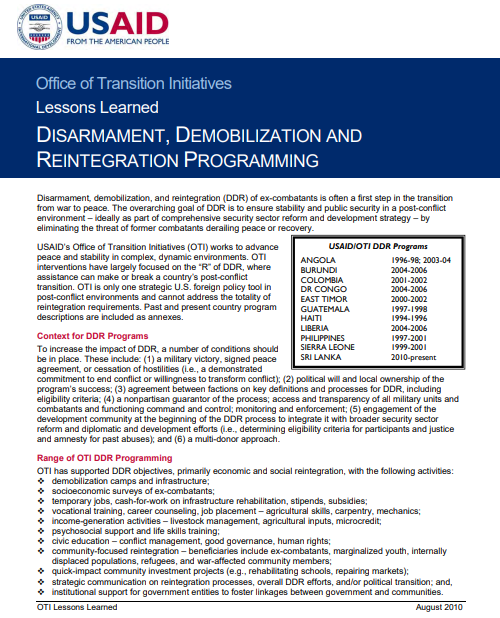USAID OTI Lessons Learned Disarmament, Demobilization and Reintegration Programming
Source: USAID | Year: 2010
Disarmament, demobilization, and reintegration (DDR) of ex-combatants is often a first step in the transition from war to peace. The overarching goal of DDR is to ensure stability and public security in a post-conflict environment – ideally as part of comprehensive security sector reform and development strategy – by eliminating the threat of former combatants derailing peace or recovery.
USAID’s Office of Transition Initiatives (OTI) works to advance peace and stability in complex, dynamic environments. OTI interventions have largely focused on the “R” of DDR, where assistance can make or break a country’s post-conflict transition. OTI is only one strategic U.S. foreign policy tool in post-conflict environments and cannot address the totality of reintegration requirements. Past and present country program descriptions are included as annexes.
To increase the impact of DDR, a number of conditions should be in place. These include: (1) a military victory, signed peace agreement, or cessation of hostilities (i.e., a demonstrated commitment to end conflict or willingness to transform conflict); (2) political will and local ownership of the program’s success; (3) agreement between factions on key definitions and processes for DDR, including eligibility criteria; (4) a nonpartisan guarantor of the process; access and transparency of all military units and combatants and functioning command and control; monitoring and enforcement; (5) engagement of the development community at the beginning of the DDR process to integrate it with broader security sector reform and diplomatic and development efforts (i.e., determining eligibility criteria for participants and justice and amnesty for past abuses); and (6) a multi-donor approach.
Missing Resource Form
See something missing? Want to add a missing resource? Fill out the form below. Thank you in advance.

